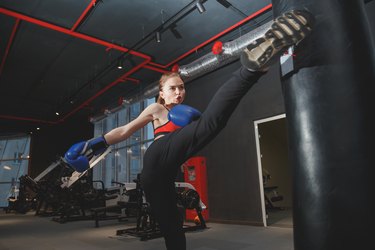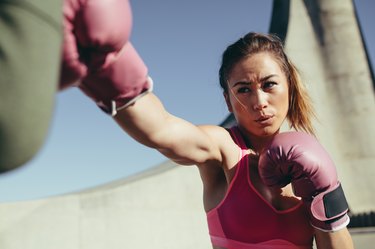
More and more women are jumping into the ring to give kickboxing a try. The fast-paced workout combines martial arts, boxing and cardio conditioning for a total-body workout that's designed to kick your butt into shape fast. Such an intense workout requires the right shoe to provide traction and support, while being lightweight enough not to slow you down.
Shoe Categories Don't Apply
Video of the Day
Athletic shoes are typically broken down into categories based on their most suitable purpose. Walking and running shoes provide more support and stability, particularly for forward motion. Tennis shoes provide support for lateral movements, with support on the inside and outside of the shoe and flexibility beneath the ball of the foot. Basketball shoes have a thicker, rigid sole for extra stability on the court. There are specialty golf, track and soccer shoes, but there are no shoes specifically for kickboxing.
Video of the Day
Kickboxing Requirements
Because you can't go to the store and pick out a specific kickboxing shoe, you'll need to know what's most important to look for. Kickboxing is a dynamic activity that requires a little bit of everything—stability, flexibility, side-to-side movement and forward-and-back motion. You'll also be doing jumps and kicks. That's a lot of ground to cover.
Here are the most important things to look for in a kickboxing shoe:
Cushioning: You want just enough, but not too much. Because kickboxing is performed inside, you won't need to worry about sticks, stones, sidewalk cracks or any other outdoor obstacles. However, you need good shock absorption, especially under the ball of the foot, for explosive jumps often featured in kickboxing classes.
Fit: A shoe that fits snugly around the mid-foot and heel is essential to provide support for multi-directional moves. It's important that the shoe isn't too wide or you'll be sliding around in it when you make quick lateral moves.
Read more: Why Is Kickboxing a Good Workout?

Flexibility: Your kickboxing shoes should feel like an extension of your own foot, a second skin. You should be able to easily bend them in all directions when they are off your feet, and when they are on your feet they should allow free movement from heel to toe and inner foot to outer foot.
Weight: A shoe that is flexible naturally has to be lightweight. A heavy shoe will weigh you down for jumps and kicks. Look for a minimal, breathable shoe that keeps you light on your feet.
A shoe that meets these criteria is often called a cross-training or aerobics shoe. Cross-training shoes allow you to do multiple sports with the same shoe; however, they vary greatly from brand to brand and style to style. Choose a shoe for its specific attributes and fit rather than its category.
Choosing Athletic Shoes
There's no one-size-fits-all when you're choosing an athletic shoe. Everyone's feet and needs are different. While knowing what to look for in a kickboxing shoe is key, making sure you find the right shoe for your foot is crucial. Keep these tips in mind when shopping for athletic shoes:
Know your foot: Do you have flat feet or high arches? Narrow or wide feet? Does your foot tend to pronate (turn in) or supinate (turn out)? Shop armed with this information for the best fit and support possible.
Buy in-store: Ordering a shoe online is fine if you know your foot. If you're in doubt, go to a reputable athletic shoe store where the salespeople are trained to do foot assessments and make suitable recommendations.
Shop at the end of the day: Feet often swell when you're active due to pressure and heat. Because you want a kickboxing shoe to be snug but not overly tight, trying on shoes later in the day will give you a better sense of how they'll fit during a workout.
Don't spend too much or too little: You shouldn't need to break the bank to get a great kickboxing shoe. On the other hand, a flimsy, poorly made shoe may save you money, but it will not aid performance and may lead to injury.
Read more: Facts About Kickboxing